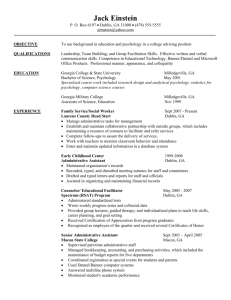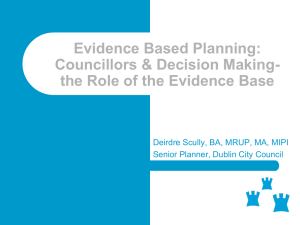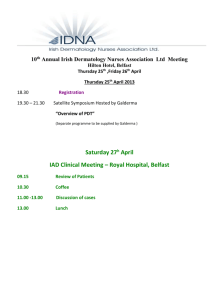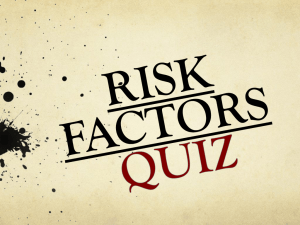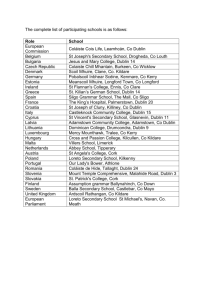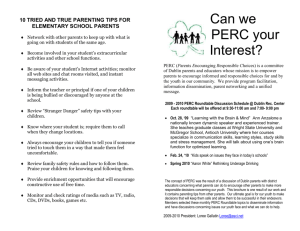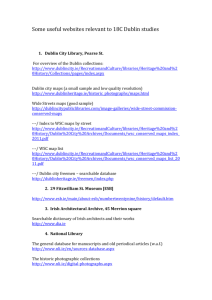Parent Resource Guide - Dublin ACT Coalition
advertisement
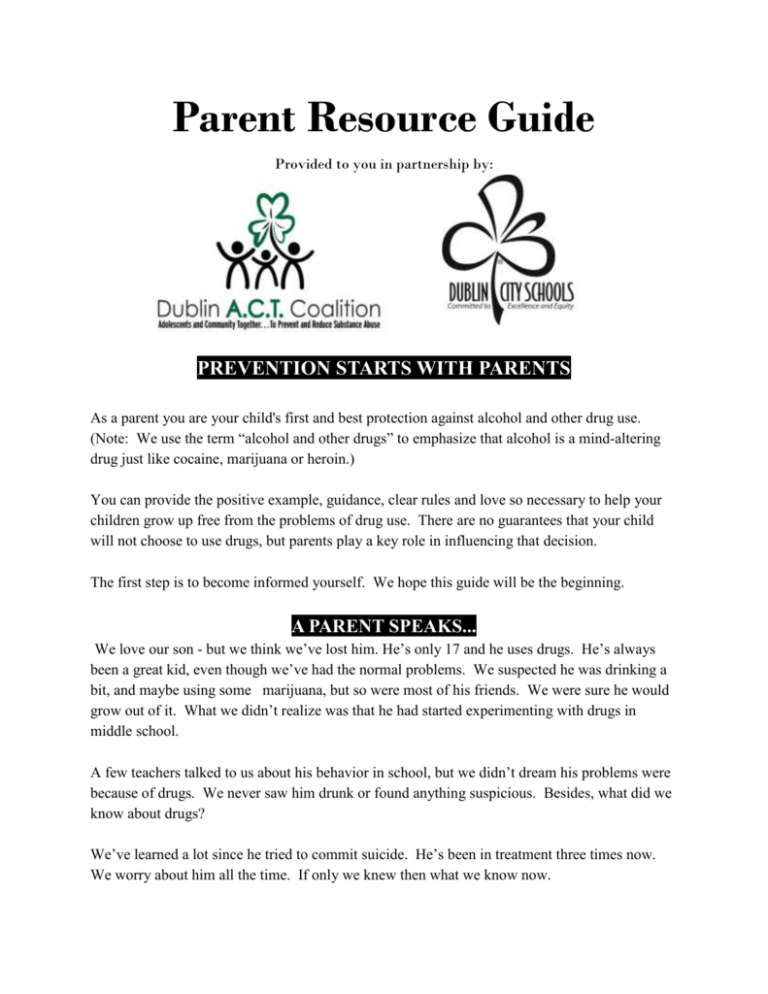
Parent Resource Guide Provided to you in partnership by: PREVENTION STARTS WITH PARENTS As a parent you are your child's first and best protection against alcohol and other drug use. (Note: We use the term “alcohol and other drugs” to emphasize that alcohol is a mind-altering drug just like cocaine, marijuana or heroin.) You can provide the positive example, guidance, clear rules and love so necessary to help your children grow up free from the problems of drug use. There are no guarantees that your child will not choose to use drugs, but parents play a key role in influencing that decision. The first step is to become informed yourself. We hope this guide will be the beginning. A PARENT SPEAKS... We love our son - but we think we’ve lost him. He’s only 17 and he uses drugs. He’s always been a great kid, even though we’ve had the normal problems. We suspected he was drinking a bit, and maybe using some marijuana, but so were most of his friends. We were sure he would grow out of it. What we didn’t realize was that he had started experimenting with drugs in middle school. A few teachers talked to us about his behavior in school, but we didn’t dream his problems were because of drugs. We never saw him drunk or found anything suspicious. Besides, what did we know about drugs? We’ve learned a lot since he tried to commit suicide. He’s been in treatment three times now. We worry about him all the time. If only we knew then what we know now. FACTS THAT EVERY PARENT SHOULD KNOW *The drug teens are most likely to use and abuse is alcohol. *Today's marijuana is 10-20 times stronger than the marijuana used in the 1960's. *Adolescents become addicted to alcohol in only 6-18 months: for adults this usually takes 5-15 years. *Of the 76 percent of high school students who have used tobacco, alcohol, marijuana, or cocaine, one in five meet the medical criteria for addiction. *Elementary age children who have learning or behavioral problems that go unresolved are at a statistically greater risk of alcohol/drug problems later on. *Children of alcoholics have a four-to-ten times greater risk of becoming alcoholics than children of non-alcoholics. *Typical American college students spend more on beer than they do on textbooks, although the majority of them cannot drink legally. *Thirty-four percent of high school students binge drink (have five or more drinks of alcohol in a row). *Teen tobacco, alcohol, and marijuana users are at least twice as likely as nonusers to have poor grades. Even more alarming: Teen marijuana users are about twice as likely as non-users to drop out of high school. *Forty-five percent of teens said they got their alcohol from family or at home. *Among youth who are 12 to 17 years old, 7.4 percent reported past-year non-medical use of prescription medications. *According to the 2011 Monitoring the Future survey, prescription and over-the-counter drugs are among the most commonly abused drugs by 12th graders, after alcohol, marijuana, and tobacco. Youth who abuse prescription medications are also more likely to report use of other drugs. *Eighty percent of high school students surveyed said that their parents' concerns, opinions, or expectations influence if and how much they smoke cigarettes, drink alcohol, or use drugs. REASONS WHY YOUNG PEOPLE SHOULD NOT DRINK ALCOHOL Although drinking alcohol is illegal for adolescents, there are adults who view underage drinking as “innocent, every-kid-tries it” behavior. Some adults even provide the alcohol. Because growing bodies are so sensitive to the affects of alcohol, youth are at much greater risk than adults for emotional and physical harm. 1. Alcohol is linked to a high death rate among adolescents. Of all age groups, 15 to 24 year olds have an increasing death rate. The causes: car accidents, suicides, and homicides, most of which are drug or alcohol related, all of which are unnatural causes and preventable. 2. Alcoholism in teens can develop very rapidly. It can develop within a matter of months after taking that first drink. In contrast, for an adult alcoholism usually takes 5-15 years. 3. Teenagers are still developing physically. Adolescence is a period of rapid growth. The brain, nervous system, reproductive system and liver are still maturing. Their brain and muscle mass are incomplete and much more sensitive to chemicals and drugs. The younger a child starts using alcohol, the greater the chance of becoming an alcoholic. 4. Teenagers are still developing emotionally. A young person is forming a sense of personal identity and is learning basic social skills. Alcohol disrupts this process by producing a chemical “high” that affects the process of learning how to deal with others, carry out responsibilities and handle problems. Problem drinkers cease growing up--mentally, emotionally or socially. They remain like children, even in adult bodies. 5. Adolescents usually drink to get drunk. Kids do not drink socially--they drink to get “buzzed” or “wasted.” The teenage party focus is on drinking per se rather than on other activities. Most parties have little or no parental supervision. The emphasis is on “chug-alugs and other drinking games. 6. There is no known “safe” dose of alcohol for young people. Any alcohol in the body of a young person puts her or him at higher risk for alcohol-related problems. KIDS NEED AND WANT CLEAR GUIDELINES! IT IS IMPORTANT FOR PARENTS, SCHOOL AND COMMUNITY TO SUPPORT A CLEAR, CONSISTENT “NO-USE” MESSAGE FOR YOUNG PEOPLE! IT’S THE LAW IN THE STATE OF OHIO 1. A person under the age of 21 may not purchase or consume alcohol. A person under the age of 21 may not order or purchase beer or liquor in any public or private place (unless accompanied by a parent, guardian, or spouse). 2. A person under the age of 21 may not use false identification in purchase of beer or liquor. 3. A person may not sell or furnish any alcoholic beverage to someone under the age of 21. A person who sells or furnishes an alcoholic beverage to a person under 21 years of age could be subject to a fine of up to $1,000 and/or imprisonment for up to six months, unless given by a physician for medical reasons or by the minor's parents or guardian. This means that a parent can legally give alcohol to his or her child in their home, BUT not to any other minors or it would be a first degree misdemeanor. 4. A property owner may not allow minors to possess or consume alcohol on his property. No Person who is the owner or occupant of any public or private place shall knowingly allow any Underage person to remain in or on the place while possessing or consuming beer or intoxicating liquor. Unless given by the minor's parent or guardian. 5. A person may not allow the consumption of illegal drugs (including alcohol) by minors in her/his home. A person who knowingly permits illegal drug use on her/his premises could be sentenced to 6 months in jail and fined $1,000. PLEASE NOTE THAT THE DUBLIN SOCIAL HOST LAW (CODE 116.05) STATES: No person who is the owner or occupant of any public or private place shall negligently allow any underage person to remain in or on the place while possessing or consuming beer or intoxicating liquor, unless the intoxicating liquor or beer is given to the person possessing or consuming it by that person's parents. 6. A person may not possess or use any controlled substance (i.e., illegal drugs). Possession of marijuana and other illegal drugs is prohibited under local and state statues. This includes a drug prescribed by a doctor for some other person. 7. A person may not have an open container of alcohol in his automobile or in a public place (such as a street or sidewalk). NOTE: A juvenile may be charged as a delinquent for violating any statute or ordinance that would be a criminal offense if committed by an adult. THE POSSIBILITY OF A CIVIL SUIT Parents or other adults who furnish alcohol to a minor may be financially liable in a civil suit brought against them by anyone who suffers injury or property loss because of that intoxicated minor. While parents should check local curfews, generally no one under 18 should be on the streets late at night, except for approved activities, usually school or church, unless accompanied by a parent. Curfew for minors under 13 is: Outside the school calendar: Curfew for minors 13 – 18 is: 9 p.m. to 4:30 a.m. 10 p.m. To 4:30 a.m. Midnight to 4:30 a.m QUESTIONS FOR PARENTS As a parent, you need to be aware of your attitudes and behaviors regarding the use of alcohol and other drugs because these are what your children are likely to copy. The following questions will help you take an honest look at these attitudes and behaviors. When you are feeling sad or nervous, do you usually take something to get rid of the feeling? Are you proud of how much you can drink? Have your children ever seen you drunk? Do you joke about getting drunk? Do you always rely on medication to handle minor aches and pains? Do you often take a prescription or non-prescription sleeping aid to fall asleep? Have your children seen you smoke marijuana or use prescription drugs for recreation? Do you smoke cigarettes? Is drinking often the focus of conversation in your home? Do you attend parties or events that involve a lot of drinking? Do you drink and drive? Do you ride with drivers who have been drinking? Do you use alcohol or any other drug in a way that you don't want your children to? Based on a family study by the Pacific Institute for Research and Evaluation, children are more prone to drug abuse if their parents: smoke cigarettes abuse alcohol or are alcoholics take illicit drugs use any substance to help master stress impart an ambivalent or positive attitude about drugs If you have concerns after reading this, it may help to share your concerns with another person (your spouse, a friend, or a professional). For professional help, see the listings in this booklet under Local Treatment and Counseling Services. FIRST A CHILD NEEDS ROOTS TO GROW...THEN WINGS TO FLY Your child’s attitudes and behaviors about drugs are being developed and shaped right now. As a parent you can do a lot to prevent your child’s possible future use. The time to begin is now. 1 TALK WITH YOUR CHILD ABOUT ALCOHOL AND OTHER DRUGS: Become knowledgeable and then talk with your child about how alcohol and other drugs can harm people— especially young people. Talk together frequently, and clarify any mistaken ideas, such as “everybody drinks” or “marijuana won’t hurt you.” With your spouse, communicate a clear message about family rules and consequences for use of alcohol and other drugs (including prescription drugs). 2. LEARN TO REALLY LISTEN TO YOUR CHILD Encourage your child to share his or her questions and concerns about alcohol and other drugs. Listen for what is happening in her or his world. Don’t do all the talking or give long lectures. 3. HELP YOUR CHILD DEVELOP SELF-CONFIDENCE Look for the positives in your child--and then share them. When correcting, criticize the action, not the child. Praise effort as well as accomplishments. 4. HELP YOUR CHILD DEVELOP STRONG VALUES Communicate your family values and then model these yourself. Teach your child how to make decisions based on these standards of right and wrong. Explain that these are the standards for your family, despite what other families might decide. 5. BE A GOOD EXAMPLE: Examine your own habits and attitudes about alcohol and other drugs. Your actions speak louder than words. 6. HELP YOUR CHILD DEAL WITH PEER PRESSURE Discuss the importance of individuality and the meaning of real friendships. Children who have been taught to be gentle and loving may need parental “permission” to assertively say “no” to negative peer pressure. Provide your child with some possible strategies for saying “no.” The two of you can even practice these, so when the time comes, your child is prepared. 7. MAKE FAMILY RULES THAT HELP YOUR CHILD SAY “NO” Discuss with your child in advance your expectations that they will say “no” to alcohol and other drugs. Spell out the consequences of breaking these rules. (For example, “My parents said I’d lose my driving privileges if I drink.”) Be prepared to follow through. 8. ENCOURAGE HEALTHY, CREATIVE ACTIVITIES Look for ways to get your child involved in satisfying hobbies, school clubs, and other activities that reduce boredom and too much free time. Encourage positive friendships and interests. 9. TEAM UP WITH OTHER PARENTS Work with other parents to build a drug-free environment for your children. When parents join together and take a united stand against drug use, they become more effective than when they act separately. Form a parent peer group with the parents of your children’s friends. The most effective way to stop a child from using drugs is to stop her/his friends from using them too. 10. KNOW WHAT TO DO IF YOU SUSPECT A PROBLEM Realize that no child is immune to the lure of drugs. Learn the telltale signs of alcohol and drug use. Take seriously any concerns you hear from friends, teachers or other kids about your child’s possible drug use. Trust your instinct. If you feel in your gut that something is wrong with your child, it probably is. If there’s a problem, seek professional help. WHEN YOUR TEEN IS GIVING A PARTY... Set the ground rules ahead of time. Let your teen know what you expect of her/him as a host. Rules for the party should include the following: Adult supervision; No drugs, including alcohol; No smoking; No gate crashers allowed; No leaving the party and then returning; Lights should be left on; Certain rooms of the house are off limits Plan in advance. Go over party plans with your teenager and set the guest list. A party “by invitation only” can curb the “open party” situation. Keep parties small (10-15 teens per adult). Have plenty of snacks and non-alcoholic drinks. Encourage your teen to plan some organized group activities or games. Set a time limit. Set a definite start and ending, not too long. Check local curfew laws in setting an appropriate ending time. Know your responsibilities. Explain to your teen that you are legally responsible for anything that happens to a minor who has been served drugs or alcohol in your home. Include your teen in this feeling of responsibility. Guests who bring alcohol should be asked to leave. Be ready to notify the parents of any teens arriving intoxicated to ensure their safe transport home. Be visible and available, but keep a low profile. Pick out a spot where you can maintain adequate supervision. You can also bring in snacks and serve beverages. Invite another parent or couple. Other adults are company and can help you if you need it. WHEN YOUR TEEN IS GOING TO A PARTY... Call the host parent. Call to verify the party and offer assistance. Make sure the parent will be present and that alcohol and other drugs will not be permitted. Know where your child is going and with whom. Have the telephone number and address of the party, and ask your teen to call you if the location of the party changes. Also, let them know where you will be at that time. Discuss how to handle possible situations. Let your teen know what you expect her/him to do if alcohol or drugs are offered. Help develop comfortable ways to refuse such drugs. Know how your teen will get home from the party. Make it easy for your child to leave a party by making it clear that he or she can call you, a neighbor or a friend for a ride home. Discuss the possible situations in which she or he might need to make such a call. Urge your teenager NEVER to ride home with a driver who has been drinking. Be up to greet your teenager when she or he comes home. Be awake or have your teen wake you when she or he arrives home. This can be a good way to check the time, as well as a way to talk about the evening. TOBACCO, ALCOHOL, MARIJUANA Tobacco, alcohol and marijuana are the drugs that young people use most often. Each of these is destructive in its own right. Plus, the use of any one of them seems to “open the door” to involvement with other drugs. TOBACCO Smoking, chewing and dipping all involve the use of nicotine. The nicotine in tobacco is one of the most addicting of drugs. Nearly 400,000 lives are lost each year to cigarette-related diseases. Long-term use of tobacco results in high blood pressure, heart attack, o chronic bronchitis, pneumonia, emphysema, and cancer of the lungs, o throat and mouth. ALCOHOL Like cocaine or marijuana, alcohol is a drug. It can alter moods, cause changes in the body and become habit forming. The most widely used drug among teenagers, as among Americans in general, is alcohol. Drinking is the third leading cause of death in the U.S. after heart disease and cancer. Alcohol is responsible for well over half of the fire deaths, drownings, injuries, traffic fatalities, and murders in the U.S. Long-term use of alcohol can result in loss of memory, high blood pressure, enlarged heart, liver ailments (severe swelling, hepatitis, cirrhosis), impotency and ulcers. MARIJUANA (POT) WEED Today’s marijuana is 10-20 times more potent than that used in the 1960’s. The active ingredient in marijuana (THC) accumulates in the body. It takes 3-6 weeks for the body to get rid of the chemicals in just one marijuana joint. Those who smoke more, continue to build up those chemicals. Long-term use of marijuana adversely affects the lungs, heart, brain, reproductive system, and the body’s immune response to infections and disease. The younger the user, the more damaging the effects. It is rare for young people to ever use any other illegal drugs without having first used marijuana. **PARENTS MUST BE AWARE THAT YOUNG PEOPLE ARE ESPECIALLY SENSITIVE AND SUSCEPTIBLE TO THE CHEMICALS IN DRUGS. PARENTS MUST UNDERSTAND THAT EXPERIMENTATION WITH ALCOHOL AND OTHER DRUGS MAY PROGRESS FROM CASUAL USE TO HEAVIER USE AND FINALLY TO DEPENDENCY. DON’T BE MISLED BY: “I’ve only tried it once.”;“It’s not mine; I was just holding it for a friend.”;“Everyone is doing it.”;“It’s only a little beer.”;“I’ve quit.” AWARENESS IS THE KEY WHO IS YOUR CHILD'S BEST FRIEND? WHAT ARE THEIR PARENTS' NAMES? DID HE/SHE COMPLETE THEIR HOMEWORK LAST NIGHT? WHO IS YOUR CHILD'S FAVORITE TEACHER? WHEN WAS THE LAST TIME YOUR CHILD WAS EXCITED ABOUT SOMETHING? WHAT GAMES DOES HE/SHE ENJOY? WHAT IS HIS/HER FAVORITE MUSIC GROUP? WHAT WAS THE LAST MOVIE HE/SHE SAW? WHO IS YOUR CHILD'S HERO? PRESCRIPTION DRUGS: Since 2007, unintended drug overdoses have exceeded car crashes as the leading cause of accidental death in OH. More than 25% of Ohio high school students reported using a prescription drug without a doctor’s prescription at least once. 70% of those who reported using prescription drugs non-medically got them from friends or relatives. Keep your family and home safe: Inventory all medication in your home. Note the number of pills and refills remaining. Secure your medications. Medications need to be locked up. Discard expired or unused medications properly. Protect your family. It is important that parents and other adults talk with youth about the addictive nature of prescription medication and the dangers of sharing medication, taking another person’s medication, or utilizing your own medication in a way other than prescribed . FUNDING FOR THIS RESOURCE PROVIDED BY: THE DUBLIN A.C.T. (Adolescents and Community Together) COALITION The Dublin A.C.T. Coalition was created in early 2008 in response to the U.S. Surgeon General’s “Call to Action on Underage Drinking.” In Fall of 2010, the Coalition was awarded a 5-year, Drug Free Communities Support Grant via The Office of National Drug Control Policy (ONDCP) and The Substance Abuse and Mental Health Services Administration (SAMHSA). These funds, in conjunction with the receipt of annually awarded Cardinal Health Foundation Grants, expanded the work of the Coalition to addressing the multi-faceted issues of youth substance use with particular focuses on Alcohol and Underage Drinking, Marijuana, and Prescription Drug Abuse in the City of Dublin. The goals of the Dublin A.C.T. Coalition are focused on evidence-based, drug prevention strategies proven to create population-level change including: providing community education, addressing access and availability, policy development and enforcement, and media messaging. The Dublin A.C.T. Coalition is comprised of active members representing a diverse group of key community stakeholders including but not limited to: The City of Dublin, Dublin City Council Members, Dublin Police, Dublin City Schools, Dublin Counseling Center (serving as the fiscal agent for the coalition grants), Cardinal Health and the Cardinal Health Foundation, Nationwide Children’s Close to Home Center of Dublin, Youth to Youth International, P.E.R.C., Healthy Community/Healthy Youth Coalition, Kiwanis of Dublin, Neil Kennedy Recovery Clinic, Dublin Springs, The Drug Free Action Alliance, local faith based leadership, Dublin business leaders, and concerned parents, youth and citizens just like you! To find out more about the exciting work of the Dublin A.C.T. Coalition and the ways in which you can be an active partner in making a difference in your own community please visit: www.dublinact.com HOW CAN I TELL IF MY CHILD IS USING DRUGS? While it is difficult to distinguish typical adolescent behavior from drug-induced behavior, parents should consider possible drug use if they notice several of these changes in their child: Changes in Physical Appearance Physical Evidence of Drug Use lack of personal cleanliness, messy appearance red eyes and frequent use of eye drops runny nose, congestion, coughing wearing dark glasses when not necessary pale face, circles under eyes Changes in Eating and Sleeping Habits difficulty falling asleep, insomnia inappropriate napping significant weight loss or gain poor appetite sudden appetite (especially for sweets) spends night in unsupervised homes liquor missing or watered down fake ID mouthwash, breath sprays visine or other eye drops roach clips, rolling papers bongs, pipes, and small screens baggies containing dried leaves, seeds “stash” cans, often disguised as cola or beer cans burning incense, room deodorizers prescription medicine disappearing Any drugs or drug paraphernalia you find on your child or in your home are indications of drug use, even if she/he insists they “belong to a friend.” Changes in Behavior and Personality Changes in Friends and Interests abrupt changes in mood hostility, defiance of rules depression, “I don’t care” attitude lack of responsibility; not doing chores or homework; forgetting family occasions blaming, lying, making excuses loss of memory, shortened attention span, disordered thought patterns withdrawal from family, isolation, secretiveness Changes in School or Job Performance Positive Attitudes Toward Drugs & Alcohol failing grades, neglected homework frequent tardiness and absenteeism falling asleep in class discipline problems quitting or getting fired from job new or different friends, especially those who use drugs friends rarely introduced and seldom come to the house more time spent in room or away from home secrecy about actions and possessions hobbies, sports or extracurricular activities are given up; everything is “boring” stays out past curfew or sneaks out at night pro-drug messages on posters or clothing strong defense of the occasional use of drugs by peers; thinks adults “hassle” kids easily angered when confronted about chemical use others are concerned over her/his use of alcohol or other drugs WHAT SHOULD I DO IF I SUSPECT MY CHILD IS ON DRUGS? If, after going through the preceding checklist, you are concerned that your child may be using alcohol or other drugs, you must share your concerns with your child. Don't discuss use with him/her while he/she is high. Select a time when interruptions will be minimal. Be very specific about the behavior you have observed. Share the checklist with him/her. In a straightforward way, tell your child about your concern and the reasons for it. Explain why you are opposed to any drug use and how you intend to enforce that position. BE: Understanding (“I realize a lot of kids use drugs.”) DON'T BE: Sarcastic (“Don't think you're fooling me!”) Firm (“As your parent, I can't allow you to engage in harmful activities.”) Accusatory (“You're a liar!”) Supportive (“We love you and sense something is troubling you, in which case we want to help.”) Self-pitying (“How could you do this to me?”) Remember, if your child is using drugs, she or he needs your help. Don't be afraid to be a strong parent! Nevertheless, the problem could become too much for you to handle alone. Don't hesitate to seek professional help, such as counseling, a support group, or a treatment program. EMERGENCY NUMBERS CHOICES FOR VICTIMS OF DOMESTIC VIOLENCE Emergency shelter 224-4663 HUCKLEBERRY HOUSE Runaway/emergency shelter for teens 294-5553 NETCARE Emergency mental health services/assessment 276-2273 DUBLIN COUNSELING CENTER 889-5722 POISON CONTROL 1-800-222-1222 POLICE EMERGENCIES POLICE NON-EMERGENCY LINE (DUBLIN) To report underage drinking/social host violations (you can choose to remain anonymous when making a report) 911 889-1112 RAPE HOTLINE 267-7020 SEXUALLY TRANSMITTED DISEASES (STD) 645-7772 SUICIDE PREVENTION HOTLINE 221-5445 NATIONAL SUICIDE PREVENTION LIFELINE 1-800-273-8255 LOCAL SERVICES FOR ASSESSMENT, COUNSELING AND TREATMENT Statistics confirm that most of the one million families who will be hit by a drug problem for the first time this year will experience the tragedy alone and without help. This need not be the case for Dublin families. There are resources, programs and caring professionals close at hand and ready to help. NAME Dublin Counseling Center LOCATION 299 Cramer Creek Court Dublin, Ohio 43017 889-5722 SERVICES Counseling services for adolescents and families Neil Kennedy Recovery Clinic 6543 Commerce Parkway Dublin, Ohio 43017 210-0416 Adolescent and adult treatment for alcohol other drug problems; And Outpatient care NETCARE mental health 199 South Central Avenue Columbus, Ohio 43223 276-2273 Comprehensive mental health and assessment; Crisis Services Maryhaven 1791 Alum Creek Drive Columbus, Ohio 43207 445-8131 Adolescent and adult treatment for alcohol and other drug problems; Outpatient and inpatient care Nationwide Childrens Hospital 5700 Perimeter Drive Dublin, Ohio 43017 335-8080 Counseling services for behavior health children, adolescents And their families Dublin Springs 7625 Hospital Drive Dublin, OH 43017 717-1800 Mental health and addiction treatment center providing Services for those 18 (+) and families DRUG TESTING SportsSafe 18 Grace Drive Powell, OH 43065 847-9848 or 888-3377 FRANKLIN COUNTY SUPPORT GROUPS NETCARE Crisis Mental Health Care 276-2273 Adult/Child Crisis and Entry System Al-Anon/Alateen 547-1550 Help and support for family, teenagers, and friends of alcoholics Alcoholics Anonymous 253-8501 For people who want to stop drinking: meetings daily Columbus Public Health Department 645-7417 Hands On Central Ohio (formerly known as FirstLink) 221-6766 General help for local emergency resources Narcotics Anonymous 252-1700 For persons desiring recovery from narcotics addiction National Alliance on Mental Illness (NAMI) Support services for families living with mental illness 224-2700 IMPORTANT SCHOOL TELEPHONE NUMBERS Bailey Elementary School Chapman Elementary School Deer Run Elementary School Glacier Ridge Elementary School Indian Run Elementary School Olde Sawmill Elementary School Pinney Elementary School Riverside Elementary School Scottish Corners Elementary School Thomas Elementary School Wright Elementary School Wyandot Elementary School Davis Middle School Grizzell Middle School Karrer Middle School Sells Middle School Dublin Coffman High School Dublin Jerome High School Dublin Scioto High School Dublin Schools Central Office Westbridge Academy GeorgiAnn Diniaco, PhD 717-6611 761-5864 764-5932 733-0012 764-5928 764-5936 798-3570 764-5940 764-5963 764-5970 538-0464 761-5840 761-5820 718-8600 873-0459 764-5919 764-5900 873-7377 717-2464 764-5913 766-3036 (Safe & Drug-Free 764-5950 Schools Programming Families are the best protection young people have against drugs.
